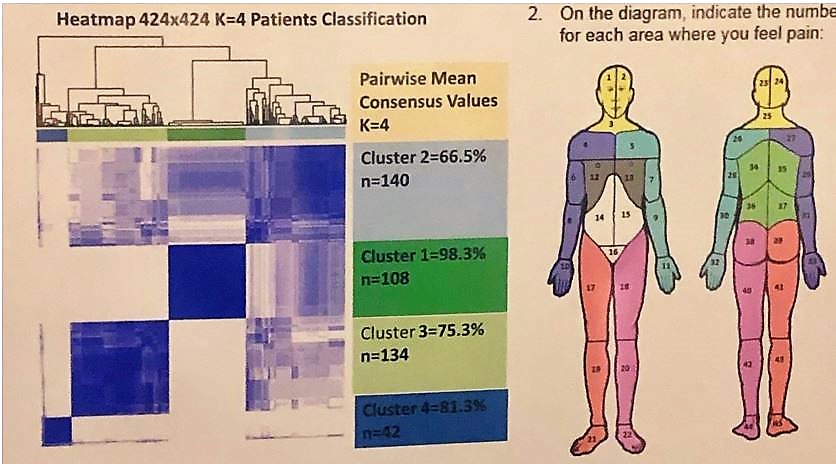Brief Pain Inventory body map was utilized to document 45 potential pain sites. These data were assigned to 4 patient groups with various pain profiles using Consensus clustering technique. The study cohort included 233 women with IC/BPS and 191 men with CP/CPPS. Data analysis showed that the most common pain sites were pelvis (85%), lower back (39%), lower abdomen (33%), front of the head (27%), and back of the neck (22%)(Figure 1).

Figure 1
Cluster 1 research participants reported pelvic pain only. Patients in Cluster 2 identified both pelvic pain and some minimal pain beyond pelvis. Cluster 3 subjects indicated pelvic pain, minimal pain beyond pelvic area, and a 100% back pain. Cluster 4 participants had pelvic pain and widespread pain at other sites (Figure 2).

Figure 2
Chronic overlapping pain conditions were noted. They included irritable bowel syndrome (IBS), fibromyalgia (FM), chronic fatigue syndrome (CFS), migraine, and temporomandibular joint dysfunction (TMJ). There was a statistically significant difference in symptom improvement in patients in Cluster 1 compared to 3 other groups (Figure 3).

Figure 3
The study identified four distinct clusters of patients with UCPPS. Cluster one was significantly associated with urologic pelvic pain severity. Lower back pain was an important determinant of a difference in pain between the groups. Research should expend to other symptoms to improve scientific knowledge of the condition.
Presented by: Kenneth Locke, Jr., PhD candidate, University of Pennsylvania, Philadelphia, Pennsylvania
Written by: Hanna Stambakio, BS, Clinical Research Coordinator, Division of Urology, University of Pennsylvania, @AStambakio at American Urological Association's 2019 Annual Meeting (AUA 2019), May 3 – 6, 2019 in Chicago, Illinois


